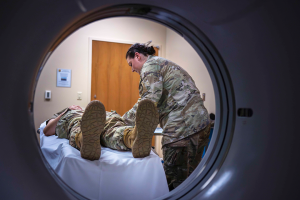
I Didn’t Sign Up For This..
When you first sign up on active duty, you are trained to detect, anticipate and guard against many threats on the battlefield. But, unfortunately, for many veterans, their greatest enemy is the one they can’t see coming: noise. Tinnitus and hearing loss are often overlooked because it becomes a routine part of our military lives.
According to the VA 2020 Annual Benefits Report, there were 2,327,387 cases of tinnitus and 1,343,013 cases of hearing loss in 2020, and the bulk of which are the result of noise exposure.
Despite how high this figure is, the backlog of claims and the high number of veterans yet to file a claim suggests this is a more important topic that deserves more attention.
So, if you think you might be suffering from or are susceptible to hearing loss, here is what you need to know, starting with the basics.
What is Tinnitus?
Tinnitus is when a person hears a constant ringing or buzzing sound. While this is a common condition affecting 15% – 20% of people, it is more common with older people.
Tinnitus is usually the result of an ear injury, age-related hearing loss, head or neck injury, or even medication. It may affect one ear or both, and the range in pitch and frequency varies from a low, buzzing sound at intervals to a constant whooshing/roaring sound.
While many people can function normally with this infection, it can be a precursor to hearing loss. In addition, tinnitus may cause anxiety or depression, sleeplessness, dizziness, hearing loss, or lack of concentration.
Hearing Loss
According to the Mayo Clinic, hearing loss affects roughly 50% of adults in the US older than age 65. It may also affect one or both ears. Hearing loss greater than 35 decibels (dB) in the better hearing ear is referred to as disabling hearing loss.
There are three main types of hearing loss:
- Conductive – this is when there is damage to the outer or middle ear. This can be reversible with medication and surgery.
- Sensorineural – this is when the inner ear is damaged, and this condition is irreversible
- Mixed – you can also have a combination of the two
Hearing loss can sometimes be improved with hearing aids, cochlea implants, or a host of other treatments.
There are hundreds of things that can cause hearing loss. While aging and constant exposure to loud noises are the usual causes for hearing loss, the latter is more common in the military.
Causes of Tinnitus and Hearing Loss in the Military
As we have emphasized a few times already, these conditions are often caused by prolonged exposure to loud noises. The most common noises are gunfire, aircraft, engine rooms, armored vehicles, and machinery.
Hearing loss and tinnitus can also be the result of head or neck injury. As you can imagine, specific service units are exposed to higher risks of hearing loss, so we’ll examine them one after the other.
Marine Corps and Army
When you’re in the infantry, you can get used to the noise emitted by weapons being discharged, but we don’t realize how loud they are. Many rifles, shotguns, and pistols have a peak sound pressure level of over 150 dB. The average human pain threshold is 110 dB, the equivalent sound of a typical car horn.
So, exposing yourself to these sounds constantly is akin to torture. The Occupational Safety and Health Administration (OSHA) recommends that nobody should be exposed to over 115 dB of sound for more than fifteen minutes a day.
There is a lot to dissect here, but let’s move on.
Navy
Being out at sea should be a quiet, peaceful endeavor. Unfortunately, however, 68% of the crew on an aircraft carrier during flight operations are exposed to dangerous noise levels. What aggravates this further is there isn’t enough recovery time.
When you’re part of the land forces, your ears have some time to heal when you sleep. Unfortunately, naval sleeping quarters on ships are usually close to communal areas and other noise-producing zones. So, over a 24-hour period, as many as 93% of the crew can be exposed to the 80 dBA recommended by the American Conference of Governmental Industrial Hygienists (ACGIH).
Compared to the land force, it still doesn’t seem too bad. However, if you work on the deck of an aircraft carrier, you can experience anywhere from 130 to 160 dBA. By comparison, the engine room and cargo deck seem paltry at roughly 100 dB. Yet, that can still cause severe damage when you spend longer than 3 hours per day there.
Air Force
Spending long hours in or around helicopters and fighter jets is another major cause of concern. The noise levels from typical helicopters exceed 100 dB when 100 ft off the ground, while a fighter jet taking off is 150 dB.
Noise levels may be slightly less for the pilots, but they are exposed to it for much longer.
What is the Disability rating for Tinnitus and Hearing Loss?
As the VA is aware of all these risk factors, it comes as no surprise that tinnitus and hearing loss are the most common disabilities.
If you can prove that your tinnitus is connected to service, you can expect a disability rating of 10%. The VA rarely gives a rating higher than this unless it has led to other service-connected disabilities .
Given the severity of hearing loss, you can get a disability rating anywhere from 10% to 100%. Yes, 100% is a stretch, but it is possible.
Conclusion
With all that we are exposed to during service, it is a miracle that more people haven’t been diagnosed with hearing loss or tinnitus.
If you have been diagnosed with a hearing impairment of some sort, then it is your right to file a claim. We know the challenges of filing claims on your own and the insanely high rebuttal rate, which is why our experts are ready to help you create a bullet-proof VA claim.
View any of our consultation packages or contact our team to get started, and let’s get you the compensation you deserve.


